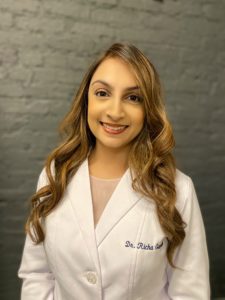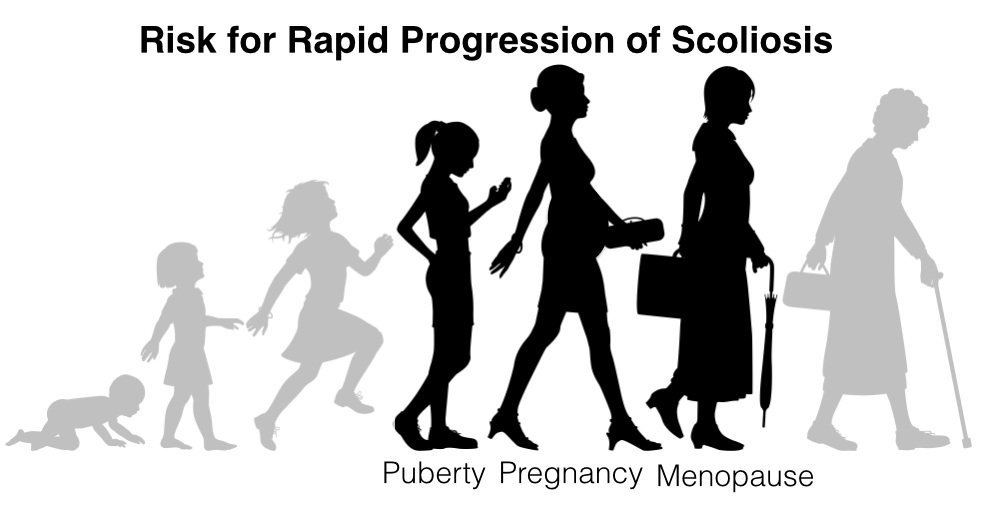December 6, 2019
Adult Scoliosis Types and Treatment Options
 Posted by Dr. Richa Gandhi
Posted by Dr. Richa Gandhi
Common Types of Adult Scoliosis and Treatment Options
Adult scoliosis is the presence of a lateral deviation in the spine which measures at a Cobb angle of 10 degrees or more in a skeletally mature patient. There are 2 common types of adult scoliosis:
Type 1: Adult Degenerative
Also referred to as Adult “De Novo” scoliosis is present in adults due to arthritis in the spine. This leads to vertebral body asymmetry which in turn causes an abnormal curvature of the spine. Most often patients present with back pain and joint stiffness. This type of curvature is most commonly located in the lumbar spine (low back).
Type 2: Adult Idiopathic Scoliosis
This curvature was present when the patient was an adolescent and has progressed into adulthood. You can think of it as a continuation of adolescent idiopathic scoliosis. Patients commonly complain of low back pain and stiffness, radiating pain down the leg and muscle fatigue. This type of curvature is most commonly located in the thoracic spine (upper back) and lumbar spine (low back) and can be shaped like an S-curve or C-curve.
Treatment Options
Non-operative:
The goals of non-operative treatment for adult scoliosis is to provide pain relief and strengthen core and spinal muscles to improve overall function and quality of life. This can be achieved through:
-Bracing
-Exercises
-Nutrition
Operative:
Surgery should be considered if non-operative treatments have been unsuccessful or for severe cases which will not respond well to conservative treatments.
December 4, 2019
Adult Scoliosis Causes & Treatment – What to Know
Scoliosis is a deformity of the spine that is highly common among children who are going through puberty. Though it is most common with children, it is not unusual for adults to have a curvature in the spine as well.
Some adults may not even be aware that they already have scoliosis until they start to feel symptoms like numbness, difficulty in walking, and uneven shoulders, among others. If you are experiencing such symptoms, know that scoliosis can be controlled with regular exercise and a healthy lifestyle. Surgery is not always an option to treat adult scoliosis and may only be considered when the patient experiences pain with incapacitating symptoms.
Below are two common Adult scoliosis causes:
Structural scoliosis – this is considered as the more serious type because it does not straighten on its own and may also lead to more deformity in the spine. The spine’s structure is affected, and if left untreated, it will become permanent.
Non-structural scoliosis – also known as functional scoliosis, this type does not affect the structure of the spine.
Causes and symptoms
Adult scoliosis causes include those who developed it at a younger age. Adults may notice the scoliosis because the bones in their spine become weaker and can get easily damaged as they age. Most often, the first symptom you feel when you have scoliosis as you age is back pain. However, in some cases, the presence of pain is minimal. Below are several other symptoms of scoliosis:
- Height loss
- Uneven alignment of the hips and pelvis
- Shortness of breath
- Numbness or weakness of the legs
- Feeling full when scoliosis is pressuring the abdomen.
How is adult scoliosis diagnosed?
Scoliosis is often diagnosed through a physical exam wherein the doctor will check your spine and its curvature. There will be nerve tests by checking your reflex, sensations. The doctor will also check your muscle strength.
The doctor may request X-rays to view a full image of your spine. There may be instances also where they will request an MRI to rule out any possibilities of a tumor. It is also important that you inform your doctor regarding your lifestyle and daily activities so that they will know how scoliosis affects your quality of life.
How is adult scoliosis treated?
Conservative treatment
Typically, adult scoliosis is treated without surgery. It is recommended that you regularly visit your doctor, and they will most likely prescribe over-the-counter pain medications.
With conservative treatment, exercise routines and physical therapy are recommended to improve the curvature of the spine, to manage the pain, and to strengthen the spine.
There are times that the pain cannot be managed by over-the-counter pain relievers. In such instances, the doctor will inject epidurals near the spine area or nerve block injections for more effective pain management.
Surgical treatment
In more severe cases, surgery will be recommended to manage adult Scoliosis. However, surgery is not a popular treatment because of the higher risk of complications. Yet, it is needed when the pain is severe on the legs and back and does not respond to conservative treatment. If the spine is imbalanced, and it begins to affect the quality of life of the patient, the doctors will recommend you to undergo surgery as well.
If you are looking for a scoliosis chiropractor in NYC to help you treat scoliosis, get in touch with us today to see how we can help.
December 4, 2019
Our Guide To Schroth Method: Exercises for Scoliosis
Scoliosis is a common spine condition that is found in a whopping 3 million adolescents in the United States, a number that rises every year for children ages 10 to 12 years old. It’s a spinal problem that happens during the different stages of a growth spurt before puberty, wherein the spine develops a sideways curvature.
Most cases of scoliosis are non-threatening. However, some may struggle with further deformities as the victims grow. This will eventually lead to compromising the patient’s lungs, which results in difficulty in breathing and even disabling in worst-case scenarios. Symptoms include the following:
- Uneven shoulders
- Uneven waist
- One hip higher than the other
That’s where the Schroth method comes in, a form of physical therapy that aims to correct the curvatures of the spine.
What is the Schroth Method for Scoliosis?
As mentioned above, the Schroth method is a physical exercise that helps patients strengthen the inner muscles of the rib cage to elongate the trunk and improve the spinal shape. The non-invasive treatment will include specific activities tailored to the needs of the patient, though most will rely on corrective breathing techniques to centralize the spine.
What Can You Expect from the Schroth Method?
Beyond developing muscles to straighten the spine, the corrective exercise also aims to achieve the following:
- Stabilization of the curve
- Mobilization of stiff body parts
- Improve postural alignment
- Teach activities for a healthier lifestyle
- Promote corrections
- Enhance neuromuscular control
- Increase muscle strength and endurance
- Pain reduction
- Improve cardio-pulmonary function
Each therapy session will have a duration between 45 to 60 minutes, depending on the severity of the patient’s scoliosis. With that in mind, most will revolve around low-impact exercises wherein a physical therapist will hold the body to assist in standing, sitting, and lying down positions.
Meanwhile, the regimen also includes props like wall ladder, poles, exercise bands, and therapy balls to add a dynamic approach on top of breathing and posture correcting techniques.
Essential Components of the Schroth Method
1. Muscular Symmetry
The muscles in your back are highly dependant on the curvature of the spine, which means that individuals with scoliosis may suffer from uneven muscle strength. One side will weaken through the years, while the other will overwork itself, creating a painful imbalance. Schroth exercises aim to strike a balance and enhance the back’s muscular symmetry.
2. Rotational Angular Breathing
Scoliosis affects the rib cage, which can cause breathing difficulties for the patient. Schroth exercises help rotate the spine using a rotational angular technique that reshapes the surrounding tissue and promotes better breathing for individuals.
How Does the Schroth Method Help Treat Scoliosis?
The conservative exercises will help patients realign their posture without the use of any surgical interventions. It allows individuals across the world to keep the symptoms of scoliosis at bay by using stretches and tailor-made exercises to strengthen the inner muscles of the rib cage.
This method will centralize the curvature of the spine in all three planes of the body, which also increases lung capacity and improve the patient’s overall posture.
If you are looking for a scoliosis chiropractor in NYC, get in touch with us today to see how we can help.
October 24, 2018
Scoliosis Progression – Sign and Symptoms Of Rapid Progression Curves
What Can Cause Your Scoliosis To Progressive Rapidly?
pedist consider that once a child stops growing the risk for progression of their scoliosis goes away, the fact is that this is only partially true. While the risk for rapid progression diminishes greatly at skeletal maturity, it is not the only time in life that scoliosis can progress. In fact, for a woman with scoliosis there are 3 times in her life that she risks rapid progression of her scoliosis curves, if she’s not doing anything to stabilize her spine.
3 Times of Life A Woman’s At Risk For Scoliosis Progression
- Puberty – Rapid Growth & Hormonal Changes
- Pregnancy – Hormone Relaxin Relaxes Ligaments
- Menopause – Bony Changes
Additional Risk for Slow Progression of Scoliosis
In addition to the risk for rapid progression scoliosis research shows that once a curve reaches a certain tipping point (generally considered around 30°) gravity really starts to takes advantage of the imbalanced spine. Gravitational pull can cause a slow progression of about 1° per year. At that rate it would mean a 14 year old girl with a 30° curve, if she did nothing to help stabilize her spine, could end up with a 50° curve by the time she is 34 years old.
Keys to Scoliosis Correction & Stability
Moving the Body More Towards the Mid-Line – Reduces imbalanced gravitational forces
Strengthen Specifically Weakened Muscles in the Spine and Trunk – Relieves muscle strain to the other side
Improve Patterns of Movement and Postural Awareness – Keeping your spine from collapsing into the downward spiral of scoliosis
July 7, 2017
Are Low Levels of Phosphorus Protective Against Scoliosis Progression?
Are Low Levels of Phosphorus Protective Against Scoliosis Progression?
Calcium and Phosphorus are at normal levels in Adolescent Idiopathic Scoliosis (AIS):
Calcium and Phosphorus are both important for normal bone mineralization, and can be mobilized to and from the blood stream and into the bone depending upon body homeostasis. Hormones (Parathyroid hormone and Estrogen) are mostly responsible for signaling when the minerals should be stored or released.
